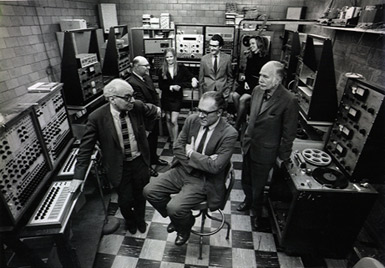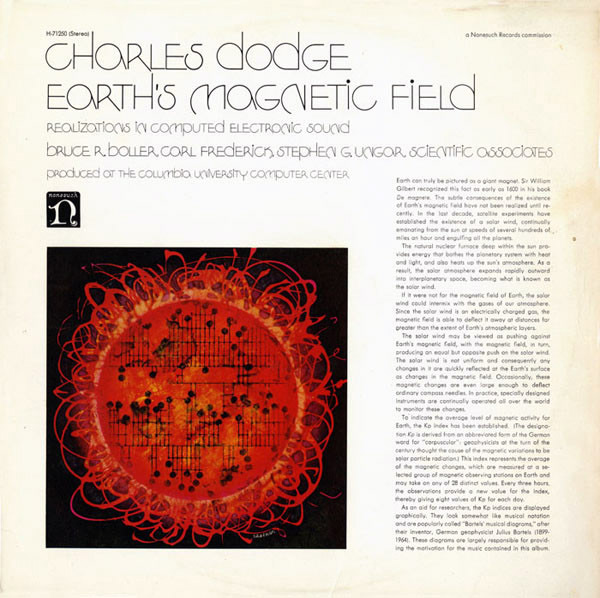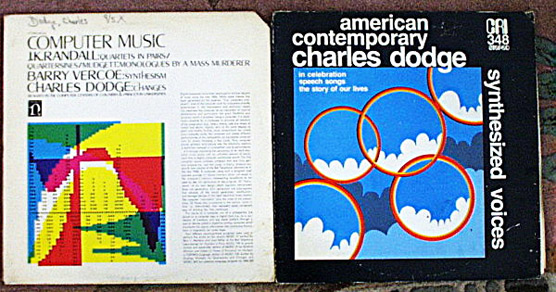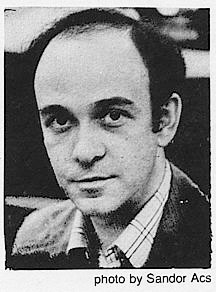The Columbia-Princeton Electronic Music Center
Frank da Cruz
Columbia University*
February 2001
Most recent update: Sat Sep 2 19:37:37 2023
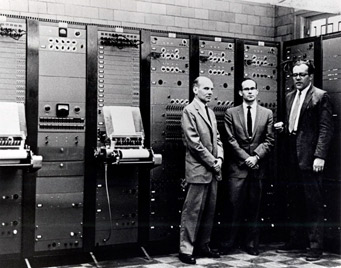
|
Photos: From the Columbia University Computer Music Center archives, accessed February 2001 and December 2019. Click each photo to magnify.
From Peter Mauzey:
I was a student from 1948 to 1958 and taught electrical engineering from 1952 to 1962. But I don't remember any computer facilities for students or staff during those years. Your document has 1962 or so as the founding of CUCC, about the time I joined what was then Bell Telephone Laboratories, owned by AT&T. I have still some association with Columbia.There was at what was then The Columbia-Princeton Electronic Music Center a Z-80 based computer that used big (8-inch "frisbee") floppies, an LSI CRT terminal, and a dot-matrix line printer. I think the name of the computer maker was Cromemco. We installed a switch in the LSI terminal to reset the computer and built a small rack-mounted panel to simplify transferring files between the Cromemco and other computers, some of which were reached by modem. Lim-Lip Yuen constructed the panel and graduated in 1992 so I know the Cromemco was acquired well before then. The Cromemco ran a good BASIC. Some code was also written in assembler. The Cromemco was still at Prentis (632 West 125), and working, when my association with the Center faded "under new management" following the death of Professor Vladimir Ussachevsky.
I'm pleased that I was able to get Virgil deCarvalho, now in charge at Abacus Consulting, Inc., to write about some early computer activity at the Columbia-Princeton Electronic Music Center. Virgil was in charge of engineering at the C-PEMC after I joined Bell Labs in 1962.
From Virgil deCarvalho (18 February 2001):

Charles Dodge ran the computer music program at Columbia until, I think, the late 1970's. Earth's Magnetic Field (1970) and Changes (1970) were two computer pieces by Dodge that I know of that were produced using facilities at the Columbia Computer Center and the C-PEMC; both were published on vinyl LPs by Nonesuch Records. [Howard Eskin of Watson Lab collaborated on these productions; Howard was also Virgil's advisor.]I met Charles Dodge when he asked me if I could build some filters for the DAC (digital-to-analog converter) he was using at Columbia's Nevis Labs in Irvington, NY, a division of the Physics department. There was a large IBM 360 (360/44 ?) machine at Nevis that was hooked up to a DAC. Dodge was able to get time on this machine and he used it to convert his digital music to analog tape. We installed a four-track Ampex 354 tape deck in the computer room and eventually built filters and a replacement DAC (the IBM DAC was really more suited for driving analog mechanical devices than for sound). The process: music (and speech) was directly synthesized using the [IBM 360/91] mainframe at the Columbia Computer Center; the synthesized output was written to open-reel digital tape; the tapes (and also punch cards) were transported to Nevis where they were converted to analog sound (for a reason I didn't understand, the IBM 360 had to stop whatever it was doing to do the conversions) and recorded onto analog tape using the Ampex 354; the analog tape was brought to Prentis for editing.
Mark Zuckerman took over the Computer Music program in the late 1970s and (at some point) purchased a used Data General Supernova computer and Kennedy tape drive unit (we built a new DAC and filters and the Ampex was brought over from Nevis) and installed them at Prentis to do music conversions. This machine's sole purpose was to convert music that was written to digital tape (at the Computer Center) into music that was written to analog tape. Now the Computer Music program owned its own music conversion equipment and no longer had to beg time from Nevis, where the physics people were getting increasingly irritated by the use of their computing equipment for something as trivial as music.
Purchasing the Data General saved a lot of time because students could get the results of their work without having to wait for things to go to Nevis and come back. And there were days when large experiments were crunching at Nevis and conversion could not happen at all -- this was not real-time. However, the Data General had one little quirk. When it was powered off (which happened sometimes), we often had to boot-strap it back into operation by manually keying in a small program using the many toggle switches on the front panel -- a real pain.
Bootstrapping minicomputers from their console switches was standard procedure through the mid-1970s. You literally had to load 16-bit binary words -- the instructions of the bootstrap program -- one bit at a time ("touch typists" could do three at a time in octal) into the switch register, deposit them in successive memory locations, and then load the starting address of the program into the program counter, then press "start". -ed.
The Cromemco Z80 was bought in 1978 for a project (The CPEMC Digitally Driven Studio) involving computer control of analog synthesizer devices in the studio. I believe the Z80 used a disk operating system that was earlier than CP/M (I may be wrong). Ussachevsky was interested in bringing computer automation to the EMC and in 1977 asked me for an idea. I proposed that we build a computerized device that would drive the voltage-controlled synthesizer equipment in the studio. I wrote a proposal that was submitted for an NEA grant of $2000 or so. While we were waiting for the grant approval, I worked on the design of the amplifier stages (32 of them) that would turn the computer signals into control voltages. When we got the NEA money we bought the Cromemco and all of the stuff we needed to build the device. The Cromemco was chosen for two reasons: 1. it was the most advanced microprocessor on the market, 2. it was a kit and highly customizable and would allow us to insert the circuitry for the device we were building. Jim Constantine helped with the digital interface. Mark Zuckerman wrote the software in Assembly code. The computer operated on an S-100 bus architecture and we had to tap into that to get at the digital signals we needed. After many fits and starts I got the digital-to-analog amplifiers designed and we put the whole thing on perforated boards that went into the Z80 computer chassis itself. A large 25 foot long cable hung out the back of the computer and this was wired into a patch panel in studio 317 (the computer had to live outside the studio because of fan noise). Ussachevsky experimented with it for a few years and I think managed to produce a few sounds that he used in a composition. I'm not sure if anyone else tried to use it. When I was at the EMC two years ago it was still there in one of the back rooms.Prior to the Sun and NeXT machines there was a Data General Supernova in the computer studio in room 324. Mark Zuckerman brought in this machine (1977?) for the computer music synthesis program he was running. The analog end for the machine and the smoothing filters that were used to produce usable sound were custom-built at the EMC. I think this was the first computer that the Center owned for music synthesis. Prior to this the computer music program was using an IBM 360/? mainframe at Nevis Laboratories for music conversion. We built the analog end for this machine too. Somehow Charles Dodge was able to get time on the Nevis machine at night and on weekends. His students did their programming at the computer center on campus and sent their jobs on punch cards up at night with Dodge to Nevis for conversion.
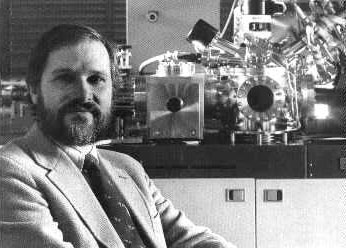
I found also 2 dusty LPs (1969 and 1976) of computer music done at CU mostly by Charles Dodge. I helped on parts as did Richard Garland at Nevis Labs. As I recall I mostly did speech recognition and synthesis software (I had been doing some R&D in that area) and I gave his class a few guest lectures on the subject.The programs were run at the Columbia Computer center (IBM 360/91) late at night. Digital tapes driven to Nevis Physics labs [in Irvington NY], where they were converted to audio via D to A converter the size of a clothes closet (now done on a chip in a generic PC).
The photo of Charles Dodge is from 1976, then assistant Professor of Music at Columbia (now at Dartmouth I think).
| * | Retired from Columbia in 2011. |
| ** | Howard Eskin was professer of Electrical Engineering and Computer Science at Columbia University, 1970-75, and Director of Academic Computing at Columbia 1975-84. During this time he collaborated with members of the Electronic Music Center, mainly Charles Dodge. Howard left Columbia in 1984 for General Electric. Howard died in 2022. |
- An Interview with Peter Mauzey, astronautapinguim.blogspot.com/, 10 May 2014, accessed 31 December 2019.
- Columbia University Computer Music Center.
- Columbia University Computer Music Center archives.
- Exhibition, Low Library, July 1 - September 15, 2006.
- Firebird Rising, Winston Nelson, Columbia Magazine, Fall 2007 (not archived).
Translations of this page courtesy of...
| Language | Link | Date | Translator | Organization |
|---|---|---|---|---|
| Albanian | Shqip | 2023-08-12 | Ermira Beqiri | NPI Finder |
| Belarusian | Беларускі | 2023/08/19 | Vladyslav Byshuk | Владислав Бишук | studybounty.com |
| Italian | Italiano | 2023/08/31 | Kerstin Schmidt | writemyessay4me.org |
| Portuguese | Português | 2025/07/24 | Jaime Gomez | essaypro.com |
| Slovak | Slovenský | 2023/08/19 | Vladyslav Byshuk | Владислав Бишук | studycrumb.com |
| Russian | Русский | 2023-06-25 | Babur Muradov | Бобур Муродов | pngset.com |
| Spanish | Español | 2023/08/31 | Kerstin Schmidt | pro-academic-writers.com |
| Swedish | Svenska | 2023/08/31 | Kerstin Schmidt | admission-writer.com |
| Ukrainian | Українська | 2023/08/19 | Vladyslav Byshuk | Владислав Бишук | skyclinic.ua |
